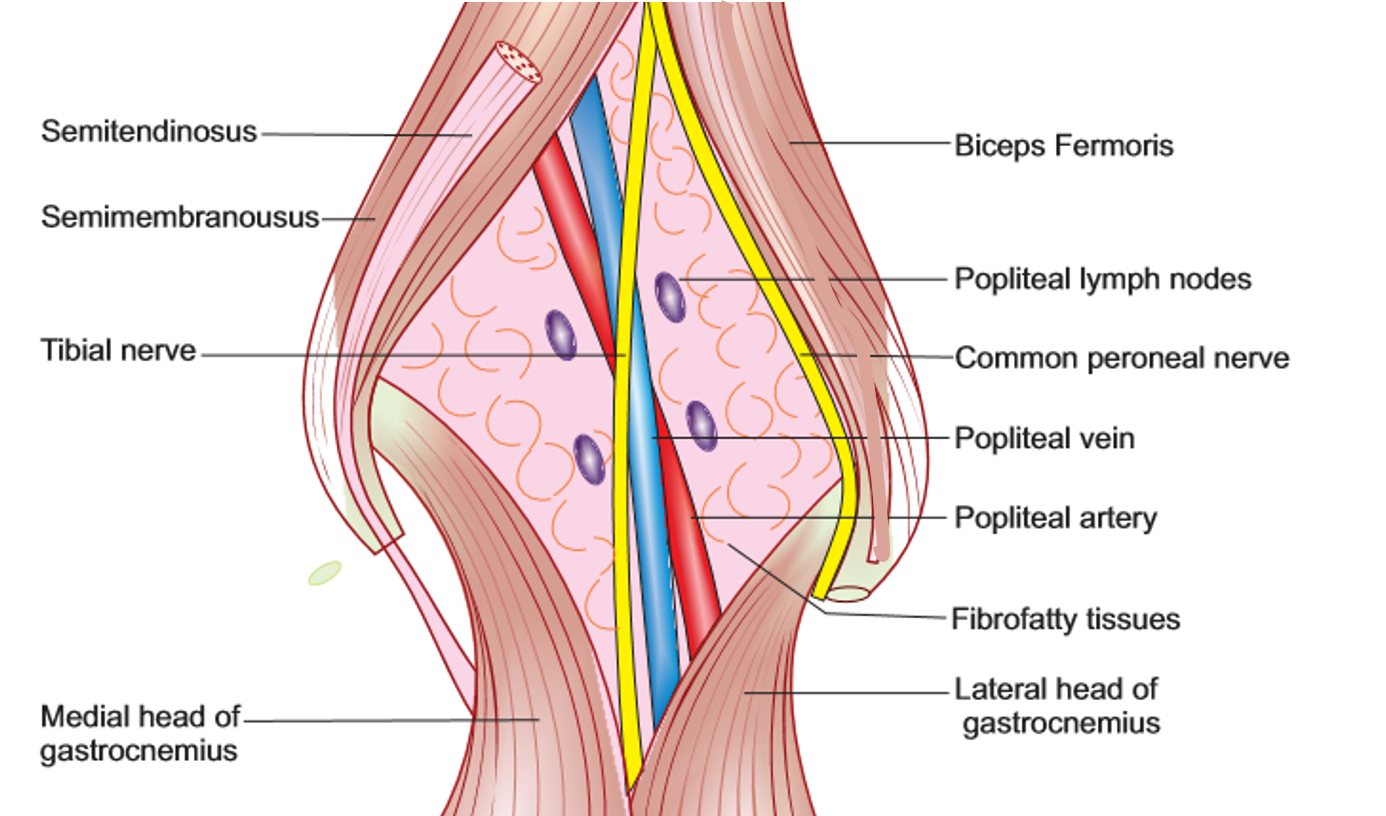What are the boundaries of popliteal fossa?
Popliteal fossa is a diamond shaped fossa on the back of the knee. Its boundaries are:
- Roof
- Is formed by skin, superficial fascia and deep fascia (popliteal fascia).
- The deep fascia in the roof is pierced by posterior cutaneous nerve of thigh and small saphenous vein.
- Floor
- Is formed by popliteal surface of femur, capsule of knee joint and fascia over politeus muscle (from above downwards).
- Side boundaries
- Superolateral: Biceps femoris muscle.
- Superomedial: Semitendinosus and semimembranosus muscles.
- Inferolateral: Lateral head of gastrocnemius and plantaris muscles.
- Inferomedial: Medial head of gastrocnemius muscles.
- Roof

Enumerate the contents of popliteal fossa
Its contents are:
- Popliteal artery and its branches
- Popliteal vein and its tributaries.
- Tibial nerve and its branches
- Common peroneal nerve.
- Popliteal group of lymph nodes.
- Popliteal pad of fat
Enumerate the branches of tibial nerve in the popliteal fossa.
Muscular branches to:
o Gastrocnemius
o Soleus
o Plantaris
o Popliteus
Cutaneous branch: Sural nerve (supplies skin of the lower part of the calf)
Enumerate the branches of popliteal artery.
Terminal branches: Anterior and posterior tibial arteries.
Genicular (articular) branches:
- Superior medial and lateral genicular arteries
- Middle genicular artery
- Inferior medial and lateral genicular arteries
Muscular branches
*Genicular arteries form anastomosis around knee joint.
Lymphatics from which areas of lower limb draini into popliteal lymph nodes.
Cutaneous lymphatics from the
o Little toe
o Lateral margin of foot
o Lateral side of back of leg.
Efferents from popliteal lymph nodes drain into deep inguinal lymph nodes.
Applied Aspects
Popliteal artery aneurysm
It is abnormal dilation of popliteal artery. It usually causes edema and pain in the popliteal fossa. The aneurysm may stretch the tibial nerve as the artery lies deep to the nerve, resulting in pain along the medial aspect of the calf, ankle or foot (area supplied by tibial nerve). A popliteal aneurysm can be distinguished from other masses by palpable pulsations.
Popliteal artery hemorrhage
As the popliteal artery is closely applied to the popliteal surface of the femur, fractures of the distal part of femur may rupture the artery, resulting in hemorrhage.
Baker’s cyst (popliteal cyst)
It is a cystic swelling in the popliteal fossa caused due to inflammation of synovial bursa beneath the tendon of semimebranosus or between medial head of gastrocnemius and semimbranousus. Popliteal cysts in adults are often secondary to degenerative or inflammatory knee joint disease (arthritis) or joint injury. There is protrusion of synovial membrane with fluid into the popliteal fossa through the joint capsule.

I really appreciate your work it’s really helpful….Thank you